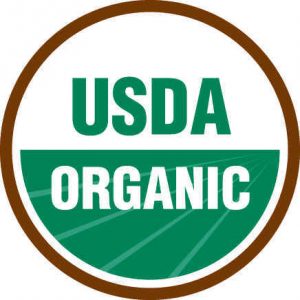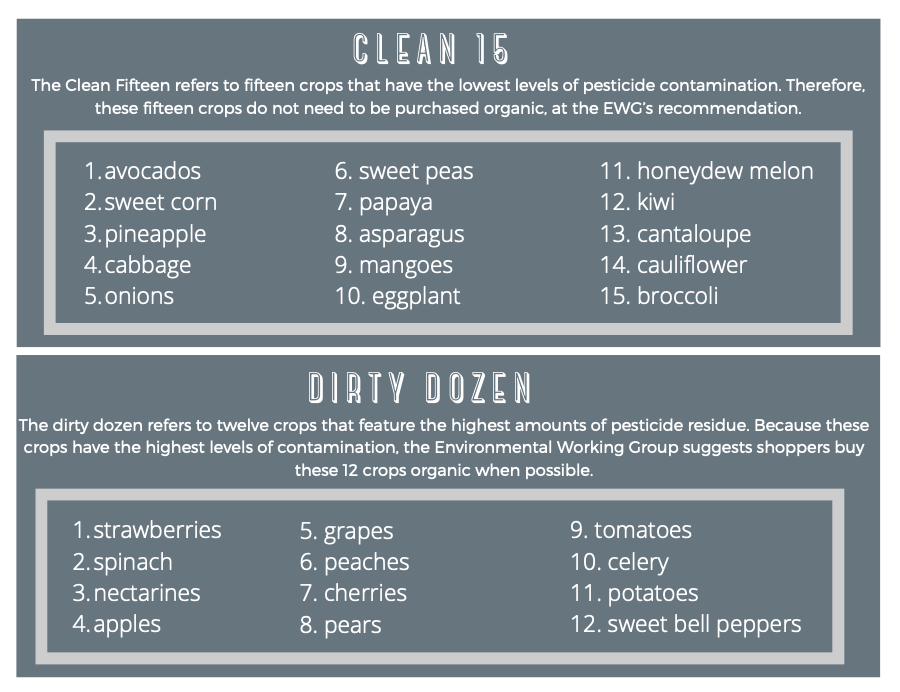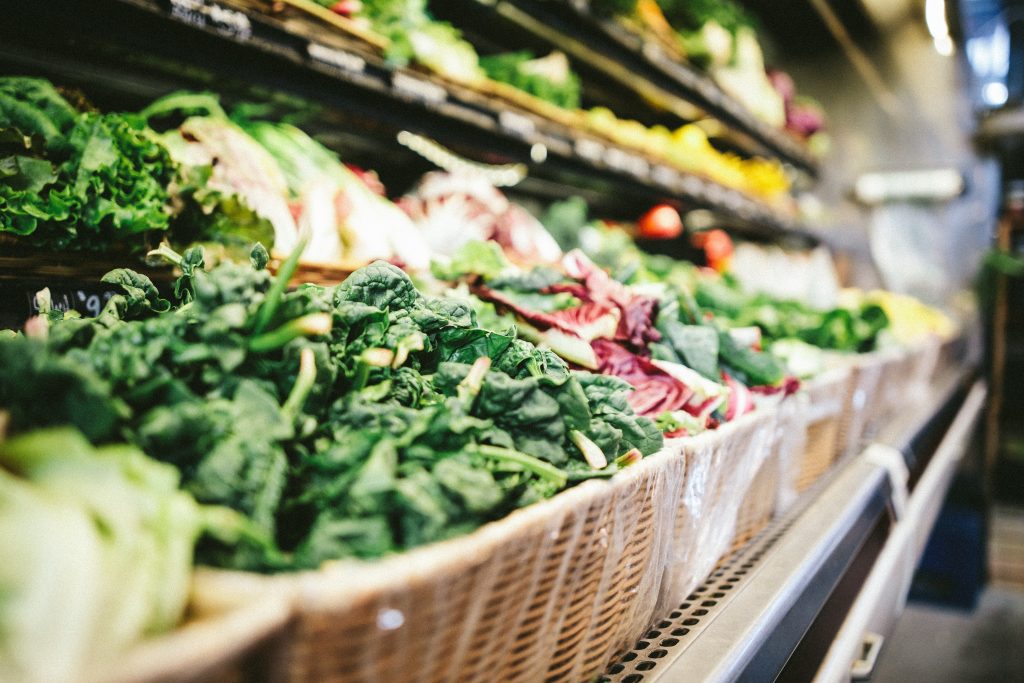Most of us have been living with organic food options for what seems like forever, but it’s actually a fairly new program. In this research round-up, I’ll provide a little background information on the organic program in the United States, what it means for you and your grocery shopping and then provide a refresher on what should be purchased in its organic form if possible and where you can save your dollars.
The National Organic Program (NOP) is the federal regulatory framework in the United States of America governing organic food. Prior to 1990, organic farming did exist, but there was no regulation, no legal oversight or consistency in the term “organic” found on products. NOP is also the name of the United States Department of Agriculture (USDA) Agricultural Marketing Service (AMS) program responsible for administering and enforcing the regulatory framework. The core mission of the NOP is to protect the integrity of the USDA organic seal. The seal is used for products adhering to USDA standards that contain at least 95% organic ingredients.
The Organic Foods Production Act of 1990 required that the USDA develop national standards for organic products, and the final rule establishing the NOP was first published in 2000.
The Organic Foods Production Act of 1990 “requires the Secretary of Agriculture to establish a National List of Allowed and Prohibited Substances which identifies synthetic substances that may be used, and the nonsynthetic substances that cannot be used, in organic production and handling operations.” It also restricts the use of the term “organic” to certified organic producers. Certification is handled by state, non-profit and private agencies that have been approved by the USDA.
NOP regulations cover in detail all aspects of food production, processing, delivery and retail sale. Under the NOP, farmers and food processors who wish to use the word organic in reference to their businesses and products, must be certified organic. Producers with annual sales not exceeding $5,000 are exempted and do not require certification (however, they must still follow NOP standards, including keeping records and submitting to a production audit if requested, and cannot use the term certified organic).
Products labeled “100 percent organic”, “organic”, or “made with organic ingredients” must adhere to the Organic Production and Handling Requirements. A USDA Organic seal identifies raw, fresh, and processed products with at least 95% organic ingredients. A product that has not been certified organic by a USDA-authorized certifying agent may not bear the USDA organic seal. Products containing at least 70 percent organically produced ingredients may include a “Made with Organic” label to specify up to three ingredients or ingredient categories. They can not use the USDA organic seal or represent that the finished product is organic. Misuse of the USDA Organic seal on a product may lead to USDA compliance and enforcement actions, including hefty fines fines possible suspension or revocation of the violator’s organic certificate.

Many people believe the FDA has oversight of organic practices in the US, but they do not. The USDA oversees the program and enforces the NOP regulations and standards. They regulate use of the term “organic” on food labels. The USDA requirements for products that are labeled with the term “organic” are separate from the laws that FDA enforces. Food products that are ordinarily under FDA’s jurisdiction and labeled with organic claims must comply with both USDA NOP regulations for the organic claim and FDA regulations for food labeling and safety.
Established by Congress in 2001, the NOP develops and enforces uniform national standards for organically-produced agricultural products sold in the United States. Operating as a public-private partnership, NOP accredits private companies and helps train their inspectors to certify that farms and businesses meet the national organic standards. USDA and accredited certifiers also work together to enforce the standards, ensuring a level playing field for producers and protecting consumer confidence in the integrity of the USDA Organic Seal.
USDA organic products have strict production and labeling requirements. A few things that might disqualify an item from organic certification are the use of synthetic fertilizers, GMOs, antibiotics, growth hormones, and feed made from animal byproducts. If you recall, in the GMO article, I stated that if you are looking for non-GMO foods, buying organic will guarantee that you are getting non-GMO.
While most synthetic pesticides are banned from organic farming, a long list of more “natural” substances are allowed by the USDA. Some pesticides commonly used by organic farms include copper, sulfur, dairy cultures, and vitamin B.
Buying organic doesn’t have to be limited to the supermarket. The cotton that’s grown on organic farms can be found in products like clothing, feminine hygiene products, and cotton swabs.
While there’s no noticeable difference in nutrition between organic and conventionally farmed food, buying organic offers other benefits. Organic practices like regular crop rotation and minimum tillage is good for the soil, and helps to cultivate land that’s more sustainable and rich in nutrients. Issues like groundwater pollution, carbon emissions, and threats to local wildlife are all reduced when farms go organic.
The largest studies of the health effects of eating an organic diet have been carried out in France. In one group of more than 54,000 men and women, those eating organic foods were less likely to develop diabetes, high blood pressure, and heart disease. This link was more pronounced among men, who ate more meat and other animal-based foods than women. Among other studies, one looked at nearly 69,000 French adults and found that eating mostly organic foods reduced cancer risk by 25 percent. Hundreds of studies have looked at the nutritional profiles of various foods. Overall, they’ve found that organic fruits and vegetables have higher levels of protective antioxidants. And organic meat, milk, and eggs contain more beneficial fats, especially anti-inflammatory omega-3 fats.
A report by the nonprofit Environmental Working Group, which includes data from the FDA, estimates that more than 2,000 chemicals are allowed as additives in conventional food. Known health risks of such chemicals include hormone disruption, cancer, inflammation, brain damage, kidney stones, gout, disruption of gut bacteria, and other digestive problems. In addition, some of these chemicals are known polluters of our air and water. Pesticides and weed killers cause additional harm. Glyphosate, the active ingredient in Roundup, the world’s most popular weed killer, is considered a probable carcinogen by the World Health Organization.
Antibiotics are fed to conventionally raised animals to promote growth and prevent infection in cramped quarters. This practice leads to bacteria developing resistance to antibiotics. Antibiotic residues make it to our plate, in meat and dairy products, and contribute to antibiotic resistance in humans. At Emory University in Atlanta, a comparison between conventional and organic milk found residues of antibiotics, including drugs that are banned from use in lactating cows, in 60 percent of conventional milk. Organic milk contained none. In conventional milk, Emory researchers also found extremely high levels of growth hormone and, in up to 60 percent of samples, pesticides that included chlorpyrifos, which damages the brain. Organic milk did not contain any of these.
The evidence currently strongly suggests that avoiding pesticides and antibiotics in our food supply is beneficial for both the producers, the animals involved and the consumers, but as the National Organic Program is still relatively young, more research is necessary.
Every year, the Environmental Working Group creates a list of the produce highest in pesticides and therefore recommends you buy those in their organic form whenever possible.
Their Clean 15 list shows the produce lowest in pesticides and therefore okay to purchase in the conventional form. Below are the current recommendations:

What makes these so bad? Strawberries, which top the list as having the highest levels of residue, can contain 22 different types of pesticide residues on just one sample. One-third of all non-organic strawberries contain 10 or more pesticide residues. Spinach also makes the top of the list, coming in at the second spot. The pesticide report found that 97 percent of conventional spinach samples contain pesticide residues. In addition to pesticides, many spinach samples contained high concentrations of permethrin, a neurotoxin and insecticide that can cause transient burning, itching, skin swelling, redness, rash, and numbness or tingling of the skin. Neurotoxins affect the nervous system by damaging nerve tissue.
If you need one of these dirty dozen items and can’t find or afford the organic version, there are recommendations on how to best clean the produce. This can be tricky as some of these are very tender and can be easily damaged. If you are needing to wash a sturdier piece of produce like an apple or peach, run the fruit under cool water for several minutes, rubbing or scrubbing. You can also use a mixture of water and baking soda and scrub. The addition of baking soda has been shown to remove more pesticide residue than water alone.
For tender produce like strawberries, running under cool water alone is best so as not to damage the fruit. But you need to rinse them for several minutes and do this just before eating. If you rinse the berries ahead of time, the excess moisture will keep them from lasting as long.
You can also rinse with a solution of water and vinegar, but most people don’t enjoy the vinegar smell or taste that may linger, which is why baking soda is more recommended.
Even with careful cleaning, it is difficult to remove all of the pesticide residue, especially from tender produce like berries or leafy greens so finding a way to purchase the organic versions is highly recommended.
Bottom line: From the research that has been published, it is evident that eating the “dirty dozen” items in their organic form is highly recommended. Check the EWG’s website each year to see if the list has changed and then shop accordingly.
I do think that organic produce has become more readily available and more affordable in recent years. Sometimes, organic versions are even less expensive than their conventional counterparts. Just pay attention and shop around. And don’t forget that the buy organic recommendation applies to all versions of these items – frozen, canned and packaged products made from these items. As always, do your best and don’t let striving for perfection trip you up on your journey!
